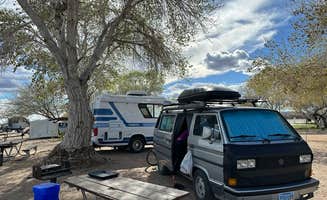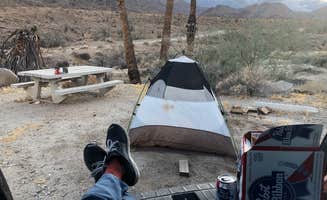Blythe, California sits at approximately 270 feet above sea level along the Colorado River, creating a unique desert camping environment with temperatures regularly exceeding 110°F in summer months. Dispersed tent camping options in this region span both California and Arizona sides of the river, with most sites accessible via dirt roads requiring careful navigation during flash flood seasons.
What to do
Desert exploration: Drive to Wiley Wells Dispersed Camping where you can access excellent hiking trails with views of Mule Mountains. One camper noted that the area features "gorgeous area and far from noisy freeway," though they caution that "there is a lot of soft sand you cannot get around. Recommend ONLY 4WD and knowledge of how to drive on sand."
Birdwatching: Visit Cibola National Wildlife Refuge for exceptional wildlife viewing opportunities. A visitor mentioned it's a "short drive to the wildlife refuge for bird watching. Lots of birds!" The refuge provides seasonal habitat for migratory birds with peak viewing from November through February.
Historic sites: Explore ancient petroglyphs at Corn Springs Campground where you can also check out an abandoned mining cabin. A camper shared: "Petroglyphs and historic mining cabin... Someone drops off scrap wood for campfires." The petroglyphs date back hundreds of years and represent a significant cultural resource.
What campers like
Waterfront access: Cibola National Wildlife Refuge East offers riverside camping with swimming opportunities. A camper noted: "It's right on the river. While I think you're supposed to pay to camp here, no one came around to check or collect payment. Sites have picnic table and grill and fire pits."
Night skies: The desert's minimal light pollution creates exceptional stargazing conditions at most BLM sites. At Corn Springs Campground, the isolation enhances the experience: "Cool place in the mountains. About 6 miles of dirt road, but fairly well maintained with minor washboarding."
Solitude: Many campers value the isolation at these desert sites. A visitor to Black Mountain Road Camp shared: "But here we found quiet solitude and a cooler evening, perhaps the winds helped." Most dispersed sites remain uncrowded except during peak winter weekends.
What you should know
Water requirements: No natural water sources exist at most dispersed sites - bring 1-2 gallons per person per day. Even at BLM dispersed camping spur at MP 133.8, where amenities are minimal, you'll need to be fully self-sufficient: "Good wide graded gravel road accesses several nice dispersed sites. Free, 14d limit, no water, trash, tables."
Road conditions: Many access roads deteriorate significantly after rain. One camper at BLM Earp noted: "The turnoff is difficult to see in time so be careful for the fast moving semi traffic behind ya. Lots of campsites along the rocky two track dirt road for a mile or so and then ends at the water canal."
Seasonal considerations: Winter camping (October-March) offers pleasant 60-75°F days while summers are dangerously hot. A camper at Corn Springs reported: "We had a lot of fun here! It was really hot so we'd only go back during winter time."
Tips for camping with families
Wildlife awareness: Teach children about desert wildlife safety including keeping distance from scorpions. A camper at Wiley Wells Dispersed - Mule Mountain described an encounter: "We put the dog inside the camper van and went back to sleep on the ground only to be woken up and surrounded by coyotes."
Recreation planning: Bring sand toys for children as many dispersed sites have sandy terrain. At Glamis Flats, a visitor suggested: "Bring your bikes and have a blast," while another noted it's "The best beach without an ocean."
Site selection: Choose camping areas away from wash areas that can flood during rain. Soft sand challenges were highlighted by one camper who recommended: "I learned quick that I need to add a shovel to my essential supplies for BLM camping."
Tips from RVers
Leveling challenges: Bring extra leveling blocks as desert terrain is rarely flat. At Glamis Flats, one RVer observed: "rv's are parallel parked, several deep. mostly dunes vs washes...no trees (as It's in the desert) nor any rv hookups."
Road clearance: High-clearance vehicles are recommended for most tent camping near Blythe, California. A camper at BLM dispersed camping spur noted: "My van was able to negotiate making an entrance, but I am leary of getting stuck. The roadway clearing similar to if a snow plow blocked you in at the end of your driveway."
Waste management: Pack out all waste and bring portable toilets as most sites lack facilities. "Pit toilets, no water, a little cell service with ATT. Half the sites were full but with quiet folks," reported a visitor about more established campgrounds.



